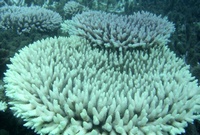
Is a coral a plant or an animal? Yes. Reef-building corals are made up of two members, an animal and a plant that lives inside of the animal. The animal portion is a relatively simple creature called a polyp, a miniature sea anemone that resembles a flower, with a circle of tentacles surrounding a mouth. Hundreds to thousands of these interconnected polyps make up a coral colony. The plant portions are single cells of algae that are too small to see with the naked eye and live inside the cells of the polyp. This relationship is called symbiosis, which means, "living together”.
Like most other plants, these “zooxanthellae" algae perform photosynthesis in sunlight and produce food for the animal (polyp) in exchange for a place to live. The polyp provides fertilizer in the form of nitrogen, and carbon dioxide, which is needed by the plant for photosynthesis. This is a wonderful relationship, and by teaming up in this way, the coral and their algae are extremely efficient solar panels that have cut out the middleman. On the coral reef, sunlight is converted into animal biomass in one simple exchange.
In the coastal waters off Tokyo, New York and San Francisco, the tiny plant cells (phytoplankton) are free-living in the water and are fed upon by tiny animals, which in turn, are eaten by small fish, who are eaten by bigger fish, and so on.
Like most animals, coral have a skeleton, but unlike mammals and fish, their skeleton is formed by the outer skin and is external to the polyp. This "exoskeleton" is made up of a white, chalky material called calcium carbonate, which is known more commonly as limestone.
Source:
http://www.dfw.gov.mp/downloads/ReefEcology.htm